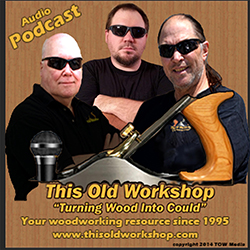Rusty Gold: Selecting a vintage saw
I get asked a lot of questions about old saws through the blog. A common one I hear a lot is, "How do I pick out a good vintage saw and avoid the garbage?" Some experts tell you to look for a particular make of saw, but I've got a better method that doesn't play favorites or require you to even know who made a saw (which can be tricky for the novice).
How's that you say? Simple. The fact is that from about 1860 to 1940, there were hardly any poorly made saws in the US. Competition and high demand in the 19th century and the perfecting of mass production in the 20th century made almost every saw made in America in this period a winner. You gotta love the good ole days.
So I've put together the following method for identifying a quality saw that literally anyone can use. You don't need to know squat about saws. In fact, about all you need is at least one working eyeball and just a touch of common sense (my apologies to those deficient in this area). That said, we're going to divide our evaluation of old saws into two parts. First, we're going to talk about QUALITY from a manufacturing stand point, and second we're going to look at the CONDITION of the saw as you find it. To find a good user saw, you're going to have to take both into account, and both have a specific set of criteria.
DISCLAIMER: Before the know-it-all armchair tool historians get fired up and throw the M-WTCA handbook at me, I would like to point out that these are not hard and fast rules. They are generalizations intended for the layman to increase the chances of him identifying a quality handsaw from a horse-manure one without any further knowledge of saws.
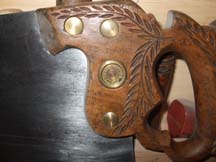 QUALITY
QUALITY1) Brass nuts: I'm talking about the hardware that affixes the saw plate (or blade) to the tote (or handle). If the nuts and bolts are made of brass, it's a mark of quality. Brass was the industry standard from the dawn of handsaw manufacturing until about the 1940s or so. After that period, steel became the standard. Now there is absolutely nothing wrong with steel nuts (I love mine), but it can be an indicator of a saw made after the point of general decline in the quality of handsaws. It just so happens that by the 1950s, quality in saws started to take a nose dive and by that time, steel nuts were the standard.
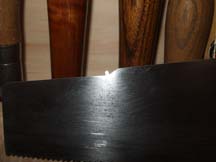 2) Nib: The nib is a decorative bump filed into the steel plate of the saw along the spine towards the toe (the narrow working end). It is not used for starting a cut. It is not for securing a tooth guard. And it's definitely not for testing the temper of the saw during manufacturing. It’s decorative. Tradition is a force not to be ignored in hand tool design, and tradition at the time said that all handsaws have a nib as decoration. Period. End of story. And if a saw has a nib, it means it was most likely made before the 1920s. Once again, nothing necessarily wrong with a saw that doesn't have a nib, but if it does, it means it was made by a tradition-conscious maker and you can bet your panther head that he was a good one. Further, it added a manufacturing step to the saw and that cost the maker money. Manufacturers didn't cut into their profit margins unless they had good reason to: Quality!
2) Nib: The nib is a decorative bump filed into the steel plate of the saw along the spine towards the toe (the narrow working end). It is not used for starting a cut. It is not for securing a tooth guard. And it's definitely not for testing the temper of the saw during manufacturing. It’s decorative. Tradition is a force not to be ignored in hand tool design, and tradition at the time said that all handsaws have a nib as decoration. Period. End of story. And if a saw has a nib, it means it was most likely made before the 1920s. Once again, nothing necessarily wrong with a saw that doesn't have a nib, but if it does, it means it was made by a tradition-conscious maker and you can bet your panther head that he was a good one. Further, it added a manufacturing step to the saw and that cost the maker money. Manufacturers didn't cut into their profit margins unless they had good reason to: Quality!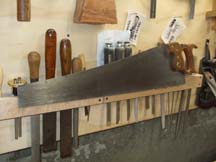 3) Skewback: This refers to he shape of the back of the saw plate. In this case, the 'skew' means that from the area in front of the tote to the toe of the saw, instead of a straight line, the shape is curved, or concave. The skewback was patented by Henry Disston in 1874 and revolutionized the handsaw industry. It was intended to lighten the saw and bring its design into the modern age. Disston took a great risk in deviating from the traditional form, but it paid off in spades. Like most of his innovations, it soon became the industry standard. It's a mark of quality for the same reason as the nib: it complicated the manufacturing process and it is helpful in dating a saw. The skewback was the handsaw to sell and to own from the 1870s until the 1920s. Again, this was the golden age of saw making in America....you can't pick a bad one!
3) Skewback: This refers to he shape of the back of the saw plate. In this case, the 'skew' means that from the area in front of the tote to the toe of the saw, instead of a straight line, the shape is curved, or concave. The skewback was patented by Henry Disston in 1874 and revolutionized the handsaw industry. It was intended to lighten the saw and bring its design into the modern age. Disston took a great risk in deviating from the traditional form, but it paid off in spades. Like most of his innovations, it soon became the industry standard. It's a mark of quality for the same reason as the nib: it complicated the manufacturing process and it is helpful in dating a saw. The skewback was the handsaw to sell and to own from the 1870s until the 1920s. Again, this was the golden age of saw making in America....you can't pick a bad one!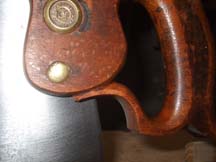
4) Lamb's tongue: The lamb's tongue is another decorative element on the tote that comes from a long tradition of esthetics. It's that curved design in front of the hand grip that licks the bottom of the handle web where the nuts affix the tote to the saw plate. Once again, this is a mark of quality because it adds a manufacturing step and cost more money. And yes, once more, as well, it helps to date the saw to the time of almost universal quality in hand saws...in this case, about any time before the 1920s.
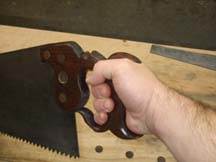
"See how the top and bottom horns of the tote on this classic English rip saw just blend right into my hand? That’s a perfect fitting tote."
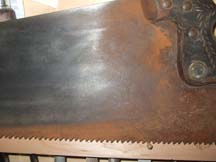 CONDITION
CONDITIONNow that you know how to differentiate a quality saw from a Quasimodo saw it's time to evaluate its condition to ascertain if it can ever be usable again. To evaluate condition, we're going to separate a saw into its three essential elements: the saw plate, the tote, and the nuts.
The Saw Plate: The two defects of concern with the saw plate are pitting and kinks. You already know that rust eats steel, and for saws, it becomes especially detrimental if the rust has caused pitting in the saw plate. Heavy pitting along the toothline will prevent some of the teeth from taking a keen edge. The only remedy for this is grinding or filing away the teeth until pit-free steel returns to the toothline, but since pitting is often rampant, this is rarely a realistic solution. The good news is that short of pitting, even heavy rust can often be cleaned off to reveal healthy steel below. Get to know what pitting looks like and how to avoid it. If the pitting is localized and slight, don't sweat it...there's plenty of other teeth to make up the work
On the right you can see the heavy orange rust that covered every inch of this saw plate. But after a good cleaning (on the letf) I find perfectly clear steel underneath.
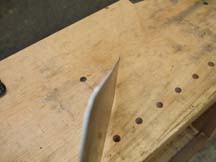
Kinks are another thing to be wary of on a handsaw. Kinks are stresses, dents, and bends in the saw plate that prevent it from being straight. Unless you want to saw like Picasso painted, try to avoid kinked saws. Kinks can be removed by a skilled saw smith, but unless you can find one, or can tackle it yourself, these saws are best passed over. Removing kinks isn't entirely too difficult, but it’s a whole other learning curve.
This is what a kink looks like down the toothline. See that bend to the left at the tip of the saw? That will require smithing to remove, or this saw will never perform well in the kerf.
The Tote: We've talked about how the tote needs to be comfortable, but besides that, it also needs to be sound and intact, or at least repairable. Broken horns are not a deal breaker...you are a woodworker, after all, right? Repairing broken horns and cracks in the tote should be fairly easy for you, but you need to be willing to tackle them. Don't tell yourself that even with breaks or serious damage a tote is "usable"...you're lying to yourself and insulting the tool gods (yes...there are tool gods). Fix it, or don't buy it in the first place.
You may also find totes with dry rot, worm holes, sun damage, syphilis, or any other number of epidermal maladies. Use your judgment on these. I'd avoid worm holes and powder post beetle damage (beetles love old beech!)...you don't want to import a cadre of these nasty little buggers into your shop. Trust me. But don't sweat a beat up or worn and cracked finish on the tote. It's uncommon to find completely intact finishes on totes, and in my opinion, they're not necessary to begin with.
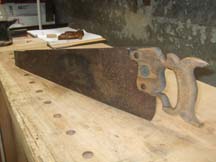
The Nuts: All the nuts should be present...both sides. If the nuts are the domed style and are missing a couple, that's not a deal breaker...they are easy to scavenge. But if they are split nuts (used on saws mostly before the 1870s) and some are missing, it can be a bear to find proper replacements. Plus, split nuts are delicate and removing them is rarely straight forward. You can replace missing split nuts with common domed nuts, but you'll become so tired of self-proclaimed saw experts lecturing you on how they aren't 'proper' that you'll want to kill them, yourself, or both
This saw may look like hell, but it passes every one of my quality tests: Nib? Check. Brass nuts? Check. Lamb’s tongue? Check. It needs a heavy cleaning and repairs to the tote, but when I’m done, this 1880s Disston #7 will live up to its reputation. These were indeed the finest handsaws ever made.
By Matt Cianci
So that's about it. Now all that's left to do is go out, find a bucket of rust, and try out that common sense you just discovered.
Enjoy! ;)
-Matt











